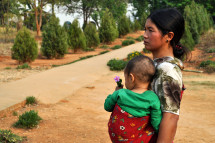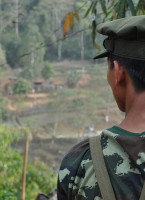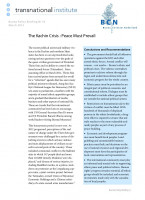Access Denied: Land Rights and Ethnic Conflict in Burma
Regions
The new land and investment laws benefit large corporate investors and not small- holder farmers, especially in ethnic minority regions, and do not take into account land rights of ethnic communities.

Authors
Burma’s ethnic minority groups have long felt marginalized and discriminated against, resulting in a large number of ethnic armed opposition groups fighting the central government – dominated by the ethnic Burman majority – for ethnic rights and autonomy. The fighting has taken place mostly in Burma’s borderlands, where ethnic minorities are most concentrated. Burma is one of the world’s most ethnically diverse countries. Ethnic minorities make up an estimated 30-40 percent of the total population, and ethnic states occupy some 57 percent of the total land area and are home to poor and often persecuted ethnic minority groups. Most of the people living in these impoverished and war-torn areas are subsistence farmers practicing upland cultivation. Economic grievances have played a central part in fuelling the civil war. While the central government has been systematically exploiting the natural resources of these areas, the money earned has not been (re)invested to benefit the local population.
Conclusions and Recommendations
- The new land and investment laws benefit large corporate investors and not small- holder farmers, especially in ethnic minority regions, and do not take into account land rights of ethnic communities.
- The new ceasefires have further facilitated land grabbing in conflict-affected areas where large development projects in resource-rich ethnic regions have already taken place. Many ethnic organisations oppose large-scale economic projects in their territories until inclusive political agreements are reached. Others reject these projects outright.
- Recognition of existing customary and communal tenure systems in land, water, fisheries and forests is crucial to eradicate poverty and build real peace in ethnic areas; to ensure sustainable livelihoods for marginalized ethnic communities affected by decades of war; and to facilitate the voluntary return of IDPs and refugees.
- Land grabbing and unsustainable business practices must halt, and decisions on the allocation, use and management of natural resources and regional development must have the participation and consent of local communities.
- Local communities must be protected by the government against land grabbing. The new land and investment laws should be amended and serve the needs and rights of smallholder farmers, especially in ethnic regions.
Photo credit: La Hpay Nang Bauk (pictured with her youngest daughter) after sharing the story of her husband who was taken by the Burmese army and has been missing for more than a month. Photo by United to End Genocide
Pages: 16

